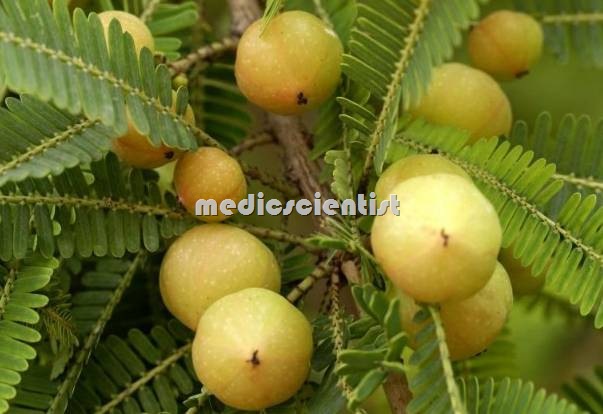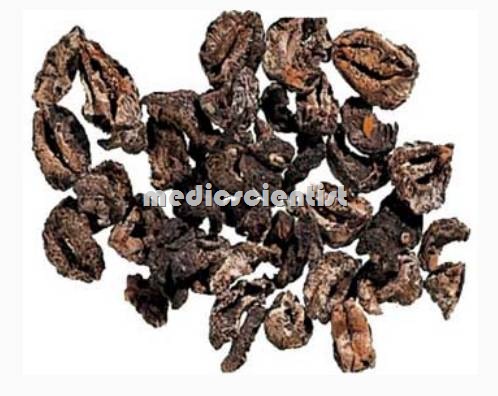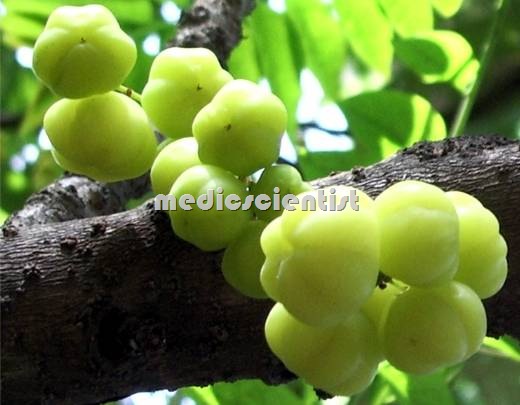Amalaki Emblica officinalis (Fam. Euphorbiaceae), Ayurveda Drug
small or medium sized tree, found in mixed deciduous forests, ascending to 1300 m on hills and cultivated in gardens and homeyards.
LATIN NAME —
- Emblica officinalis
Family —
- Euphorbiaceae
SYNONYMS Amalaki Emblica officinalis –
- Sanskrit : Amalaka, Amtaphala, Dhatr¢phala
- Assamese : Amlaku, Amlakhi, Amlakhu
- Bengali : Amla, Dhatri
- English : Emblic Myrobalan
- Marathi : Anvala, Avalkathi
- Oriya : Anala, Ainla
- Punjabi : Aula, Amla
- Tamil : Nellikkai, Nelli
- Telugu : Usirika
- Urdu : Amla, Amlaj
- Gujrati : Ambala, Amala
- Hindi : Amla, Aonla
- Kannada : Nellikayi
- Kashmiri : Embali, Amli
- Malayalam : Nellikka
DESCRIPTION and PLACES OF ORIGIN of Amalaki Emblica officinalis —
- small or medium sized tree, found in mixed deciduous forests,
- ascending to 1300 m on hills and cultivated in gardens and homeyards.
- Fruit, globose, 2.5-3.5 cm in diameter, fleshy, smooth with six prominant lines; greenish when tender, changing to light yellowish or pinkish colour when mature,
- with a few dark specks: taste, sour and astringent followed by delicately sweet taste.
- Transverse section of mature fruit shows an
- epicarp consisting of single layer of epidermis and 2-4 layers of hypodermis; epidermal cell, tabular In shape, covered externally with a thick cuticle and appear in surface view as polygonal; hypodermal cells tangentially elongated, thick-walled, smaller in dimension than epidermal cells;
- mesocarp consisting of xylem and phloem; xylem composed of tracheal elements, fibre tracheids and xylem fibres; tracheal elements show reticulate scalariform and spiral thickenings; xylem fibres elongated with narrow lumen and pointed end;
- mesocarp forms bulk of fruit, consisting of thin-walled parenchymatous cells with intercellular spaces, peripheral 6-9 layers smaller, ovoid or tangentially elongated while rest of cells larger in size, isodiametric and radially elongated; several collateral fibrovascular bundles scattered throughout
- mesocarp contains large aggregates of numerous irregular silica crystals.
CONSTITUENTS –
- Ascorbic acid and tannins
PROPERTIES AND ACTION and GUNA —
Rasa :
- Amla, Kashya, Madhura, Tikta, Katu
Guna :
- Rksha, Laghu
Virya :
- ticta
Vipaka :
- Madhura
Function or Karma :
- Tridoshar,
- Virya,
- Rasayana,
- Cakshsuya
IMPORTANT FORMULATIONS –
- Cyavanaprasa
THERAPEUTIC USES Amalaki Emblica officinalis –
- Raktapitta,
- Amlapitta,
- Prameha,
- Daha
Ayurveda DOSE Amalaki Emblica officinalis –
- 10-20 g of the drug 5-10 ml of fresh juice





